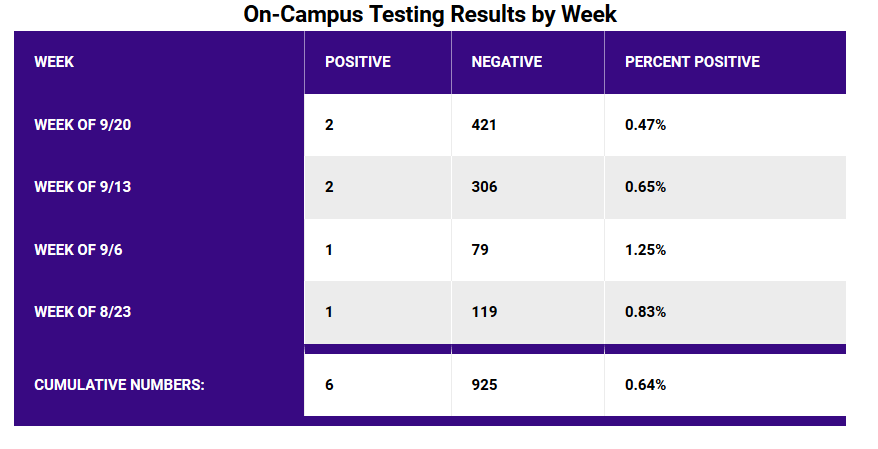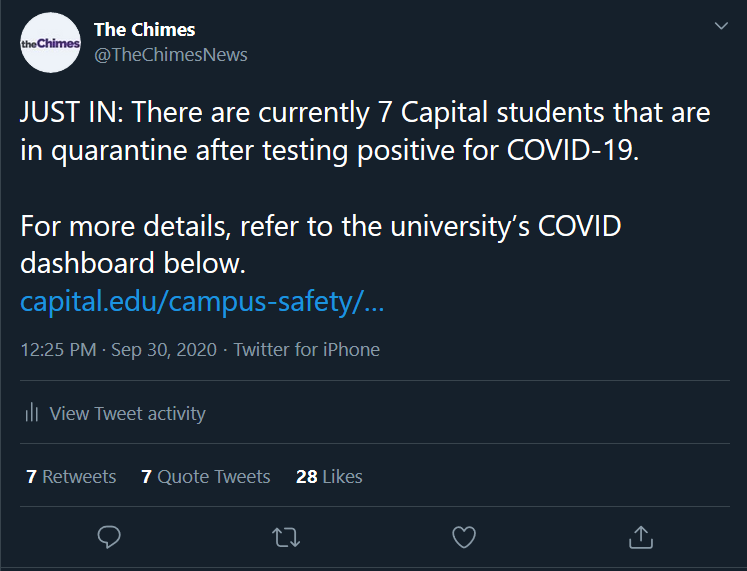UPDATED Oct. 2, 9:34 A.M. ET: The article was updated to include a tweet originally made by the Chimes on Sept. 30.
As of Sept. 29, there have so far been six total students that have tested positive for COVID-19 during campus testing, while seven students are currently in quarantine.
To start off, it’s important to draw a distinction between “isolation” and “quarantine.”
According to the CDC (Center for Disease Control and Prevention), people are placed into isolation after they’ve tested positive for a contagious disease. On the other hand, people are placed into quarantine after being potentially exposed to a contagious disease to see if any symptoms actually develop.
Isolating is far more serious while quarantining is more of a precaution.
In the case of COVID-19, there’s a 14-day incubation period to see if an individual develops any symptoms. After that period, if they show no symptoms and test negative, they’ll be able to leave quarantine.
According to the COVID-19 dashboard provided by the university, there have so far been six positive cases taken from on-campus testing. All of this data was last updated on Sept. 29.

This COVID-19 dashboard is managed by Tanya Poteet, the university counsel and Vice President for Institutional Integrity at Capital.
“When students do test positive, if they’re residential students, they’re given the option to return home for the isolation period,” Poteet said, “and many students choose that because they would rather be in the care of their family members.”
The majority of those six students that tested positive decided to return home to isolate, that’s why Capital’s current isolation amount is at zero, as you can see below.
On Oct. 1, Poteet added an asterisk under the data chart to clarify the meaning in the numbers.

“We have had a student in isolation during the semester, but currently, we do not have anyone,” Poteet said.
On Wednesday, Sept. 30, the Chimes posted a tweet announcing the release of the university’s testing data. While the tweet is partially true, the use of the words, “after testing positive,” is rather misleading for the true data. The Chimes apologizes for this error in wording. Since those students are in quarantine, they have not tested positive at the time of this writing.

Noticeably, these charts only reflect the results that were taken from on-campus testing. If a student received a test from an outside source, that data won’t be represented in some of these charts.
If a residential student does test positive and decides to stay on campus, they will be moved to a designated isolation dorm room. These isolation rooms are not spread out across multiple residential halls. There is strictly one area for these students, and that exact location could not be disclosed.
When it comes to quarantine, students do not have to move out of their original rooms. Unlike isolation, they can stay where they are.
“Quarantine students do get information from Residence life about what is available to them, and what the rules of quarantine are,” Poteet said. “I don’t know the specifics about food for quarantine students, but I do know that they have the ability to get food from the dining hall.”
Poteet wasn’t sure if the university had designated workers to make deliveries to these students or not, but suggested that the Office of Residential and Commuter Life would be able to provide more info.
At the time of this writing, the Office of Residential and Commuter Life has not been able to be contacted in regard to meal deliveries for quarantined students. Updates on this particular topic will follow soon.
To monitor and ensure that the amount of positive cases does not grow higher, the university is beginning to conduct surveillance testing on every Monday in the Harry C. Moores Student Union building. They will continuously do a random selection of residential students, commuters, staff, and faculty to be tested. The test will involve the collection of nasopharyngeal specimen, which is done by sticking a swab up into a person’s nasal cavity.


